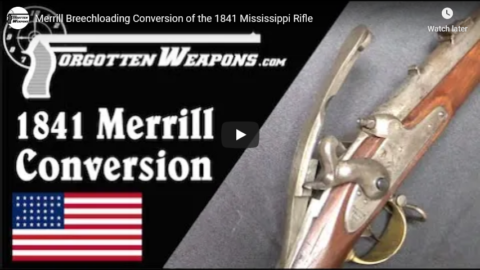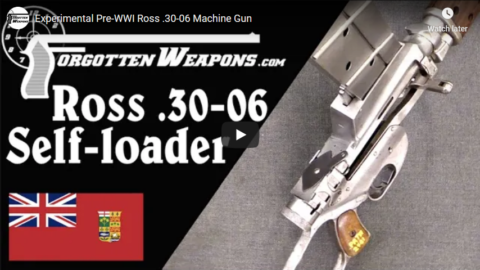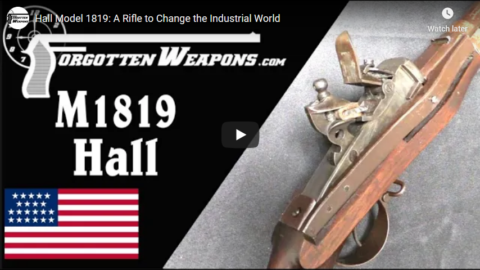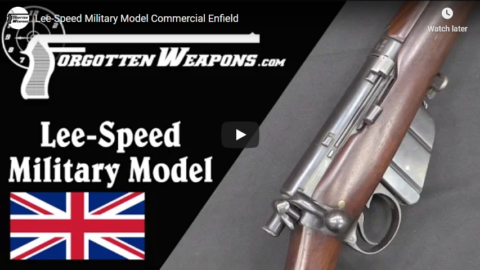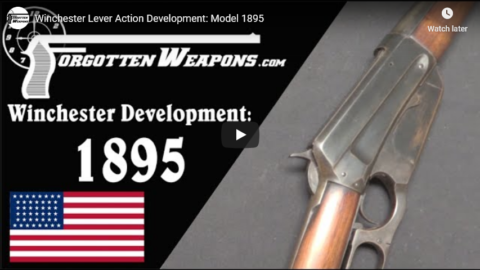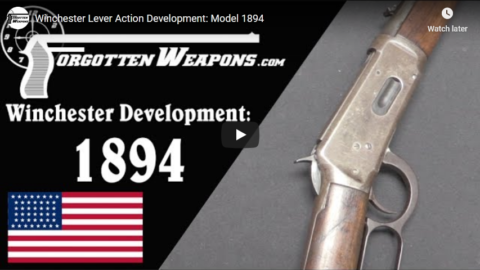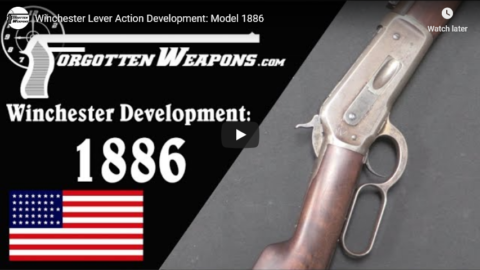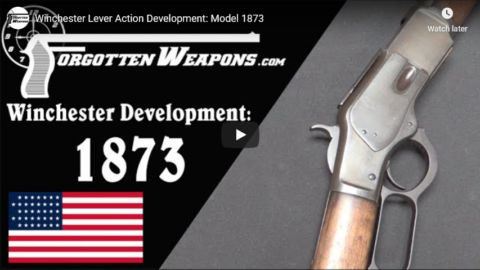Forgotten Weapons
Published 9 Sep 2020http://www.patreon.com/ForgottenWeapons
https://www.floatplane.com/channel/Fo…
Cool Forgotten Weapons merch! http://shop.bbtv.com/collections/forg…
James Merrill of Baltimore had his hand in several Civil War era firearms — rifles built from scratch, conversions of the Jenks carbines, and also conversions of 1841 Mississippi rifles done by the Harpers Ferry Arsenal. Merrill’s conversion involved a knee-joint type lever which could be opened to allow loading of a rifle from the breech. The system was relatively simple, and it was one of three (the others were the Lindner and Montstorm) made in small numbers for testing by Harpers Ferry. It appears that 300 Merrill conversions were done, 100 each of the 1841 Mississippi Rifle, 1842 musket, and 1847 musketoon.
Contact:
Forgotten Weapons
6281 N. Oracle #36270
Tucson, AZ 85740
December 17, 2020
Merrill Breechloading Conversion of the 1841 Mississippi Rifle
December 15, 2020
Experimental Pre-WWI Ross .30-06 Machine Gun
Forgotten Weapons
Published 14 Dec 2020http://www.patreon.com/ForgottenWeapons
https://www.floatplane.com/channel/Fo…
Cool Forgotten Weapons merch! http://shop.bbtv.com/collections/forg…
In August 1913, the British War Office wrote to Sir Charles Ross requesting a sample automatic rifle for trials in the UK. Ross was able to submit a prototype in May 1914, which was tested at Enfield — but only fired 308 rounds before the test ended, suggesting that something important probably broke. The gun was a very strange looking contraption, whose Ross MkIII lineage is visible only in the bolt and front of the receiver forging. A long stroke gas pistol was added, and the action flipped upside-down. A large 25-round magazine was fitted, along with a thumbhole style stock that looks very similar to the grip of a Lewis gun. In addition to one example tested at Enfield in .303 caliber, one other model was send to the US for testing, chambered for .30-06. That is the gun we are looking at today, which came to the Canadian War Museum from the collection stored at Fort Knox in the 1970s and 80s.
Thanks to the Canadian War Museum for providing me access to film this extremely unusual Ross for you!
Contact:
Forgotten Weapons
6281 N. Oracle #36270
Tucson, AZ 85740
December 14, 2020
Hall Model 1819: A Rifle to Change the Industrial World
Forgotten Weapons
Published 7 Sep 2020http://www.patreon.com/ForgottenWeapons
https://www.floatplane.com/channel/Fo…
Cool Forgotten Weapons merch! http://shop.bbtv.com/collections/forg…
John Hall designed the first breechloading rifle to be used by the United States military, and the first breechloader issued in substantial numbers by any military worldwide. His carbines would later be the first percussion arms adopted by any military force. Hall developed a breechloading flintlock rifle in 1811, had it tested by the military in 1818, and formally adopted as a specialty arm in 1819.
Hall’s contribution actually goes well beyond having a novel and advanced rifle design. He would be the first person to devise a system of machine tools capable of producing interchangeable parts without hand fitting, and this advance would be the foundation of the American system of manufacturing that would revolutionize industry worldwide. Hall did this work at the Harpers Ferry Arsenal, where he worked from 1819 until his death in 1841.
I plan to expand on the details of a variety of Hall rifle models in future videos, and today is meant to be an introduction to the system. Because it was never a primary arm in time of major war, Hall is much less well recognized than he should be among those interested in small arms history.
Contact:
Forgotten Weapons
6281 N. Oracle #36270
Tucson, AZ 85740
December 11, 2020
Shooting the Webley-Fosbery Automatic Revolver – Including Safety PSA
Forgotten Weapons
Published 10 Aug 2017Following up yesterday’s look at the history and mechanics of the Webley-Fosbery self-cocking revolvers [posted here], today we are out at the range to do some shooting with one.
In terms of handling, it is a comfortable gun to shoot, albeit with some exaggerated recoil because of the very high bore axis relative to the hand. It has an interesting two-part recoil sensation, because the upper assembly takes quite a long time to return forward into battery.
Most importantly, we discovered that this particular Webley-Fosbery has a worn hammer engagement, which results in the firing pin coming into contact with cartridge primers even when it is in the safety notch. In other words, it can — and will — sometimes fire when the action is closed and without any manipulation of the trigger. This is a condition that could happen to any Fosbery revolver, so owners should handle them with this possibility in mind! This is also a great example of why gun safety rules are redundant — occasionally guns do have mechanical failures, so don’t point them at anything you don’t want to shoot!
Thanks to Mike Carrick of Arms Heritage magazine for providing this Webley-Fosbery for this video! See his regular column here: https://armsheritagemagazine.com
Cool Forgotten Weapons merchandise! http://shop.bbtv.com/collections/forg…
http://www.patreon.com/ForgottenWeapons
If you enjoy Forgotten Weapons, check out its sister channel, InRangeTV! http://www.youtube.com/InRangeTVShow
December 8, 2020
Schmeisser’s MP-18,I – The First True Submachine Gun
Forgotten Weapons
Published 14 Aug 2017When Germany began looking in late 1915 for a new weapon ideally suited for the “last 200 meters” of a combat advance, Hugo Schmeisser’s blowback submachine gun would prove to be the weapon that would set the standard for virtually all submachine guns to come. It was a fully automatic-only weapon with a simple blowback action and a rather slow 400 rpm rate of fire. Although relatively heavy, the only real shortcoming of the MP18,I was its use of 32-round Luger snail drum magazines, which was dictated by the German military. These magazines were unreliable and difficult to load, but they were already in production and were a reasonable logistical answer in a time when material and production shortages were an endemic problem in Germany.
The MP18,I managed to see frontline combat only in the closing few months of World War One (50,000 were initially ordered, 17,677 were produced before the Armistice, and only an estimated 3,000 actually saw frontline combat use). During that time, however, it made a significant impression, easily convincing anyone with an open mind that this new type of weapon would play a major role in future wars.
After the end of the war, the Germany Army was prohibited from using submachine guns, so most of the existing ones (including the example in today’s video) were transferred to police organizations instead.
http://www.patreon.com/ForgottenWeapons
Cool Forgotten Weapons merch! http://shop.bbtv.com/collections/forg…
If you enjoy Forgotten Weapons, check out its sister channel, InRangeTV! http://www.youtube.com/InRangeTVShow
December 2, 2020
The History of the Colosseum (In LEGO!)
Overly Sarcastic Productions
Published 1 Dec 2020This video is sponsored by the LEGO Group. Learn more about the LEGO Colosseum here: https://lego.build/OSP
We’d like to thank our friends at LEGO for giving us this magnificent excuse to gush over some of the most beautiful architecture in history. This type of architectural-deep-dive is a little bit out of the ordinary for us, but it was lots of fun, so please do let us know if you found it interesting, as we’d be thrilled to do more!
Our content is intended for teenage audiences and up.
PATREON: https://www.Patreon.com/OSP
PODCAST: https://overlysarcasticpodcast.transi…
DISCORD: https://discord.gg/osp
MERCH LINKS: http://rdbl.co/osp
OUR WEBSITE: https://www.OverlySarcasticProductions.com
Find us on Twitter https://www.Twitter.com/OSPYouTube
Find us on Reddit https://www.Reddit.com/r/OSP/
November 28, 2020
FN Model D: The Last and Best BAR
Forgotten Weapons
Published 21 Aug 2020http://www.patreon.com/ForgottenWeapons
https://www.floatplane.com/channel/Fo…
Cool Forgotten Weapons merch! http://shop.bbtv.com/collections/forg…
Contact:
Forgotten Weapons
6281 N. Oracle #36270
Tucson, AZ 85740
November 21, 2020
Schwebebahn: Why Wuppertal’s Trains Are Much Cooler Than Yours
The Tim Traveller
Published 12 Apr 2018Wuppertal has possibly the world’s most badass public transport: a 120-year-old swingin’ suspension railway. But the question is: why? When everyone else was busy building trams and undergrounds, what made Wuppertal say “NOPE”, and build this instead?
***
Tom Scott Video:
https://www.youtube.com/watch?v=F4KZL…Kaiserwagen photo:
By Own work – JuergenG, CC BY-SA 3.0, https://commons.wikimedia.org/w/index…
From the comments:
The Tim Traveller
10 months ago
Hi all – just a quick note on this video: I think a few people are mishearing me at 0:43 where I say this is “the world’s oldest suspension railway… it’s also one of the world’s only suspension railways”. I did not call it “the world’s only suspension railway” — there are others, including one not too far away from here at Düsseldorf Airport, another in Memphis, US, and some more in Japan. TLDR: it’s the oldest one but not the only one. Thank you for your attention 🙂
November 13, 2020
Lee-Speed Military Model Commercial Enfield
Forgotten Weapons
Published 27 Jan 2017In 1892, just a few years after the British military adopted the Lee-Metford rifle, the BSA and LSA factories began offering several configurations on the civilian/commercial market. They would produce them all the way into the 1930s, with your choice of Metford or Enfield rifling, and in Sporting, Trade, or Military/Target configurations. The Lee-Speed name comes from the patents used in the rifles — James Paris Lee for the magazine, and Joseph Speed for several improvements to the bolt and magazine. Speed was an employee of the Royal Small Arms Factory at Enfield, and was instrumental in the development and adoption of the Lee rifles.
This particular example is a Military/Target rifle, of the Lee-Enfield MkII pattern. Note the safety lever on the cocking piece, the Martini style rear sight, and the magazine chained to the trigger guard assembly. When they haven’t been sporterized, the Lee-Speed military pattern rifles are a great time capsule of British rifle design. Military rifles were generally updated as new patterns were adopted, while these civilian guns were not.
http://www.patreon.com/ForgottenWeapons
Cool Forgotten Weapons merch! http://shop.bbtv.com/collections/forg…
If you enjoy Forgotten Weapons, check out its sister channel, InRangeTV! http://www.youtube.com/InRangeTVShow
November 5, 2020
The Range Rover Story
Big Car old account
Published 26 Feb 2019To help me continue producing great content, please consider supporting me: https://www.patreon.com/bigcar
Help support my channel through these Amazon UK affiliate links:
Range Rover t-shirt: https://amzn.to/2WVHiLX
Land Rover baseball cap: https://amzn.to/2D4DP67
Range Rover diecast model car: https://amzn.to/2U3tTzk
Range Rover keyfob: https://amzn.to/2D4HmRQIf Maria Von Trapp had driven a Range Rover, she’d have climbed every mountain, forded every stream and driven to every Austrian folk festival with the entire Von Trapp family singers in the back. Her and the Captain would have been able to roll up to the fanciest Salzburg dinner party in their finest glad rags after a day yodeling sweet nothings to each other on top of a mountain.
The Range Rover is the ultimate go-anywhere luxury SUV. It was born out of Rover’s desire to sell more cars in the USA, and its design was a complete accident. So how did a company known for saloon cars and agricultural off-roaders invent a car that created a brand-new market segment?
Much credit for this video has to go to aronline.co.uk for their excellent articles.
#RangeRoverClassic
October 22, 2020
Winchester Lever Action Development: Model 1895
Forgotten Weapons
Published 19 Jun 2017We have reached the final iteration of the Winchester lever action rifle development story today, the Model 1895. This was another John Browning design, although the locking system is basically the same as the 1894 but with the bolt extending over the top of the locking block and hiding it from sight.
The new feature of the Model 1895 was the replacement of the traditional tube magazine with a single stack box magazine located under the action. By this time, spitzer (pointed) bullets were becoming commonplace, to exploit the new high velocities made possible by the new smokeless powders. In a tubular magazine, these pointed bullets would rest on the primer of the next cartridge in the magazine, and ran the risk of causing rounds to detonate in the magazine tube under recoil. The box magazine, of course, negated this danger completely.
The Model 1895 was built around the .30-40 military cartridge, although was initially released in two black powder chamberings. It would eventually be offered in a wide variety of chamberings, including .30-03, .30-06, .303 British, and the .405 Winchester — Theodore Roosevelt’s “Big Medicine”. In addition, more than half of the total production (nearly 300,000 rifles) would be for the Russian military, with the rifles chambered for 7.62x54R and fitted with stripper clip guides.
Cool Forgotten Weapons merchandise! http://shop.bbtv.com/collections/forg…
http://www.patreon.com/ForgottenWeapons
If you enjoy Forgotten Weapons, check out its sister channel, InRangeTV! http://www.youtube.com/InRangeTVShow
October 20, 2020
Winchester Lever Action Development: Model 1894
Forgotten Weapons
Published 17 Jun 2017The Winchester 1894 has become one of the most manufactured and most popular sporting rifles in American history, and it owes this success to a combination of factors. Mechanically, the 1894 was a continued improvement on John Browning’s already-excellent 1892 model. It was strong and simple to operate, offering both speed and power. The cartridge that cannot be separated from the history of the Winchester 94 is the .30-30 Winchester, aka the .30 WCF (Winchester Center Fire).
While the .30-30 shared a naming convention with the many black powder rounds that were in use (a .30 caliber bullet over 30 grains of powder), this new round was a smokeless powder cartridge. As such, it offered a very significant increase in velocity over everything else that was then available (just shy of 2000 fps). The cartridge was well suited for taking nearly any North American game, and the package of the 94 and the .30-30 made an outstanding general purpose weapon for a huge swathe of the American market.
By 1927, one million had been manufactured (the millionth one was presented to President Coolidge), and by 2006 production had exceeded 7 million. This truly is the iconic American deer and ranch rifle — so ubiquitous that its remarkable quality has set a new standard for the entire industry.
Cool Forgotten Weapons merchandise! http://shop.bbtv.com/collections/forg…
http://www.patreon.com/ForgottenWeapons
If you enjoy Forgotten Weapons, check out its sister channel, InRangeTV! http://www.youtube.com/InRangeTVShow
October 16, 2020
Tank Chats #81 Goliath | The Tank Museum
The Tank Museum
Published 2 Aug 2019Curator David Willey talks through the aptly-named Goliath, a WW2 German tracked mine.
Support the work of The Tank Museum on Patreon: ► https://www.patreon.com/tankmuseum
Visit The Tank Museum SHOP: ► https://tankmuseumshop.org/
Twitter: ► https://twitter.com/TankMuseum
Instagram: ► https://www.instagram.com/tankmuseum/
Tiger Tank Blog: ► http://blog.tiger-tank.com/
Tank 100 First World War Centenary Blog: ► http://tank100.com/ #tankmuseum #tanks
October 14, 2020
Winchester Lever Action Development: Model 1886
Forgotten Weapons
Published 13 Jun 2017The Model 1886 was the first Winchester repeating rifle to improve on the original toggle locking system of the 1860 Henry, and it is also the first of John Moses Browning’s lever action designs. Browning met with Winchester executives to sell them his design for the Winchester 1885 single shot rifle, and mentioned that he was also working on a lever action repeating rifle that would be much stronger than the existing Model 1876. This was very interesting to Winchester, and they agreed to buy that design as well.
The new rifle used a pair of vertically sliding blocks to lock the bolt into the receiver upon firing, and allowed the weapon to safely chamber much more powerful rounds, up to and including the .50-100 Express. This rifle superseded the Model 1876 almost overnight, as it finally allowed a single rifle to have the power of the single shot buffalo rifles and the rapid firepower of the smaller caliber Winchesters.
Cool Forgotten Weapons merchandise! http://shop.bbtv.com/collections/forg…
http://www.patreon.com/ForgottenWeapons
If you enjoy Forgotten Weapons, check out its sister channel, InRangeTV! http://www.youtube.com/InRangeTVShow
October 8, 2020
Winchester Lever Action Development: Model 1873
Forgotten Weapons
Published 9 Jun 2017With the Model of 1873, Winchester was able to address the major remaining weakness of the Henry and 1866 rifles — the cartridge. The 1873 was introduced in tandem with the .44 Winchester Center Fire cartridge (known more commonly today as the .44-40). This cartridge kept the 200 grain bullet from the .44 Henry Rimfire round, but used a brass case (as opposed to copper) and was able to increase the powder charge from 28 grains to 40, for a substantial increase in velocity.
In addition, the Model 1873 used a lighter steel frame and introduced a sliding dust cover on the top of the action to help keep out dirt and debris. The centerfire nature of the cartridge made it possible to handload ammunition when a commercial source was not available (Winchester sold the reloading tools). The 1873 was available with a wide variety of options, including barrel and magazine lengths, buttstock and grips, sights, and fancy options like engraving. It would prove to be a massively popular weapon both in the United States and abroad, cementing Winchester’s position as the premier manufacturer of American repeating rifles.
Cool Forgotten Weapons merchandise! http://shop.bbtv.com/collections/forg…
http://www.patreon.com/ForgottenWeapons
If you enjoy Forgotten Weapons, check out its sister channel, InRangeTV! http://www.youtube.com/InRangeTVShow

